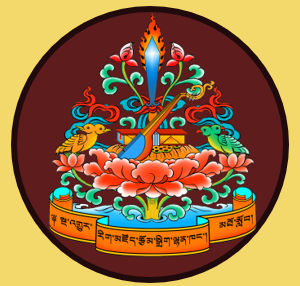The Ngagyur Nyingma school of Tibetan Buddhism consists of three kinds of transmission: Kama (the canonical teachings), Terma (the hidden treasures) and Zabmo Dagnang (the profound pure visions). In this account, the Kama tradition is highlighted. Generally, the Kama teachings comprise the sacred tantric teachings that have been transmitted from the primordial buddha Samantabhadra up to our present root guru through three types of uninterrupted lineages, which are the Mind Lineage of the Victorious Ones, the Symbolic Indication Lineage of the Vidyadharas, and the Hearing Lineage of Ordinary Individuals. In order to arouse the faith of conviction within one’s mind, it is important to know the essence of the teaching and how it was transmitted from the teachers to their respective disciples for many generations. Lord Buddha, after attaining enlightenment under the Bodhi tree in Bodhgaya, gave the first cycle of teachings, beginning with that on the Four Noble Truths, at Varanasi; the second cycle on the non-conceptual nature of all phenomena at Vulture Peak; and the third on the pure appearance of all phenomena at Vaishali, and in other places. Moreover, he widely turned the wheel of the profound Vajrayana teachings to fortunate disciples in various places such as the pure realm of Akanistha, Mt. Sumeru, Zahor, Odiyana, Amaravati, Sitavana, and so forth.
In eastern India, one hundred and twelve years after the Buddha’s mahaparinirvana, King Jah and his son, Lalitavajra, as well as Buddhaguhya and Sthiramati, propagated the Vajrayana teachings, especially the Mahayoga and Anuyoga. The great tantric master Garab Dorje and his disciples disseminated the Atiyoga teachings. The teachings and practices of the eight great principal yidams of Mahayoga were transmitted by Guru Padmasambhava and eight other famous Indian masters. Likewise, the eighty siddhas, the ‘six ornaments of the world’ and other tantric masters extensively spread the Vajrayana teachings and placed numerous beings on the path of maturation and liberation.
The Mahayoga, Anuyoga and Atiyoga are the main parts of the secret Kama teachings. The Mahayoga doctrine, the basis of all tantric teachings, consists of common tantras such as the ‘Magical Emanation Net’ (Tib. gyuthrul drawa) and the uncommon tantras of body, speech, mind, qualities and activity. The Anuyoga teaching is primarily described in the Mandala of the Sutra Which Gathers all Intentions ( Tib. do tsogchen düpai kyilkhor), and is related to the nine yanas. The Atiyoga teachings are classified into three categories: outer, inner and secret. The outer one consists of eighteen ‘mother’ and six ‘child’ tantras of the mind class ( Tib. sem de); the inner one of the spatial class (Tib. long de), explained in such scriptures as the Vajra Bridge (Tib. dorje zampa); and the secret one consists of seventeen tantric volumes.
The Kama teachings were propagated in the snowy land of Tibet during the reign of the Dharma king Trisong Deutsen. In order to lay the foundation of the buddhadharma, the king invited Acharya Shantarakshita and Guru Padmasambhava. Later the king also invited Pandit Vimalamitra, Kamalashila, Jnanamitra and other great scholars to cause the priceless buddhadharma to flourish. Then, proficient Tibetan translators such as Vairochana, Ma Rinchen Chog, Nyak Jnanakumara, Kawa Paltseg and Chogro Lui Gyaltsen as well as other minor translators, rendered almost all of the extant Buddhist canon from Sanskrit into Tibetan based on their extensive study and research. At the end of this process, the buddhadharma had fully arrived in Tibet.
Thereafter, many scholars and highly realized masters emerged, such as the twenty-five siddhas at Chimphu, the fifty-five realized masters at Drag Yang Dzong, the thirty-five lay practitioners at Sheldrag, the one hundred and eight practitioners at Yerpa and Chuwa Ri, and the twenty-five women practitioners who attained rainbow body. These realized masters liberated countless beings in complete buddhahood by instructing them in the Vinaya tradition, the bodhisattva’s path and the Vajrayana teachings.
Gradually, the Kama teachings were propagated far and wide in Tibet. In the beginning, the lineage of the profound teachings was held by Nyak Jnanakumara, in the middle by Nub Sangye Yeshe, and from the 11th century onwards they flourished through the efforts of the master of the Zur family. Eventually, the secret teachings of Dzogchen were preserved by the 14th century Dharma king Longchen Rabjam, and almost all of the trilogy of inner tantra—the Sutra Which Gathers All Intentions, the Magical Emanation Net and the mental class of Dzogchen—were upheld and propagated by the treasure revealer Terdak Lingpa in the late 17th century. Even though these teachings have flourished in Tibet due to the good fortune of the Tibetan people, many adherents of the doctrine were executed and the Buddhist texts were mercilessly destroyed when the Tibetan government succumbed to foreign invaders in the 20th century. Because of this, the buddhadharma started to decline rapidly, though it was not completely wiped out. Yet most of the teachings remained in the hands of some Nyingma doctrine holders and schools. Nyingma masters like Dudjom Rinpoche, Dilgo Khyentse Rinpoche, Penor Rinpoche, Dodrub Rinpoche and other renowned masters came to the Land of the Aryas (India) and they shouldered the enormous responsibility of upholding the tradition and overseeing the flourishing of the enlightened teachings in India as well as abroad.
By Yegay Norbu
7th Year, NNI


